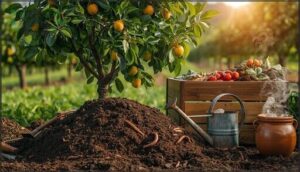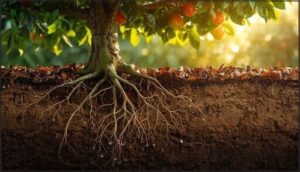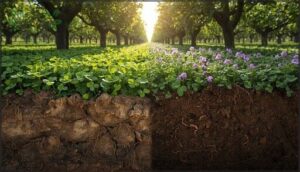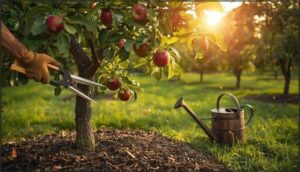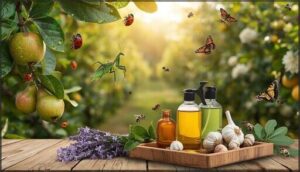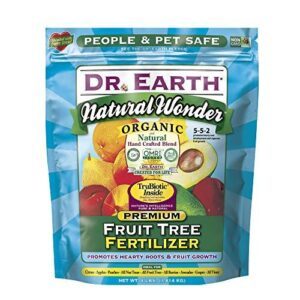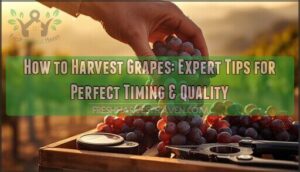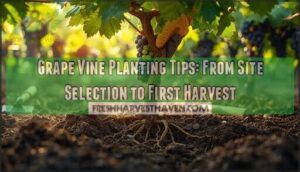This site is supported by our readers. We may earn a commission, at no cost to you, if you purchase through links.
Most commercial orchards spray their trees up to 20 times per season with synthetic pesticides—but your backyard doesn’t need to follow that script. When you grow fruit organically, you’re not just avoiding chemicals. You’re creating a miniature ecosystem where beneficial insects patrol for pests, rich compost feeds your trees slowly and steadily, and disease-resistant varieties do half the work for you.
The real secret isn’t complicated formulas or expensive products. It’s understanding how healthy soil creates healthy trees, how proper pruning prevents most problems before they start, and how working with nature beats fighting against it every time.
Whether you’re planting your first apple tree or converting an existing orchard, organic fruit gardening methods give you freedom from the chemical treadmill while producing abundant harvests that taste better and keep your family safer.
Table Of Contents
- Key Takeaways
- Choosing Fruit Trees for Organic Gardens
- Preparing Soil for Organic Fruit Gardening
- Organic Methods for Fruit Tree Care
- Natural Pest and Disease Management
- Top 6 Products for Organic Fruit Gardening
- Frequently Asked Questions (FAQs)
- Is it really cheaper to cultivate your own fruits and vegetables?
- What is a disadvantage of organic gardening?
- What are the different types of organic gardens?
- What is the easiest crop to grow organically?
- What are the rules for organic gardening?
- How to grow fruit organically?
- What is the gardening 3 year rule?
- How do you start an organic garden for beginners?
- What is an organic garden approach?
- How do you grow fruits and vegetables without pesticides?
- Conclusion
Key Takeaways
- Organic fruit gardening succeeds by building healthy soil through compost and cover crops, which creates disease-resistant trees that need minimal intervention compared to commercial orchards spraying 20 times per season.
- Disease-resistant varieties like Liberty apples and proper tree spacing (with cross-pollination partners within 100 feet) eliminate most pest problems before they start, cutting your workload in half without chemicals.
- Deep watering, annual dormant pruning, and 3-4 inches of organic mulch create strong root systems and can boost yields by 38 kg per tree while reducing disease risk by up to 61%.
- Integrated pest management combining beneficial insects, companion planting, and organic treatments like neem oil or Bt sprays can reduce pesticide use by 50% while maintaining productive harvests.
Choosing Fruit Trees for Organic Gardens
Picking the right fruit trees for your organic garden starts with understanding your unique growing conditions and goals. You’ll want to examine everything from your local climate and soil type to how much space you’re working with and which varieties can resist common diseases without chemical help.
Let’s walk through the key factors that’ll set you up for a thriving organic orchard.
Climate and Soil Considerations
Before you plant, match your tree selection to your environment—it’s the difference between thriving and just surviving. Climate zones and chill hours determine which varieties will actually produce fruit in your area. Soil pH between 6.0 and 7.0 keeps nutrient-rich soil available to roots, while microclimates near walls or slopes create warmer pockets for tender trees. Understanding the soil pH levels is vital for maintaining healthy trees.
- Test soil temperature and composition for ideal drainage
- Consider your region’s chill hours when selecting varieties
- Identify microclimates that protect against frost damage
Disease-Resistant Varieties
Choosing disease-resistant varieties cuts your workload in half and keeps your trees thriving without chemical sprays. Modern breeding programs have developed resistant cultivars like Liberty and Jonafree apples, which resist apple scab naturally. For peaches, varieties like ‘Frost’ and ‘Redhaven’ shrug off leaf curl and brown rot.
These genetic traits create sustainable orchards that align perfectly with organic fruit gardening methods while maintaining healthy soil and simplifying pest management. By using disease resistant apple cultivars, growers can reduce their reliance on chemical sprays and create a more sustainable orchard ecosystem.
Pollination and Space Requirements
After selecting resilient trees, you’ll need to think about pollinator health and tree spacing for a productive garden layout. Most fruit trees rely on cross pollination to boost fruit yield, so you’ll need compatible varieties blooming together. Proper spacing ensures pollinators move freely while supporting microclimate benefits through companion planting and alley cropping techniques.
- Standard apples need 30-35 feet apart, while dwarf varieties thrive at just 10 feet
- Cross pollination can increase apple fruit set by 15% and weight by 20%
- Place compatible varieties within 100 feet to boost pollinator movement
- Tight hedgerow spacing (2-3 feet) works with proper pruning and rootstock control
Best Fruits for Small Gardens
Once you’ve planned spacing, it’s time to pick what you’ll actually grow. Dwarf varieties give you freedom in tight spaces—think Meyer lemons at 6-10 feet or compact figs reaching just 3-4 feet. Container growing works brilliantly for citrus and strawberries, while low-maintenance fruits like disease-resistant apples (Liberty, Enterprise) keep your organic gardening simple and rewarding.
| Fruit Type | Ideal Height/Yield |
|---|---|
| Dwarf Apple | 6-8 ft / 1-4 bushels |
| Meyer Lemon | 6-10 ft / year-round |
| Blueberry Bush | 6-8 lbs per bush |
| Strawberry | 1-2 lbs per sq ft |
Preparing Soil for Organic Fruit Gardening
Healthy soil is the foundation of any thriving organic fruit garden—it’s where your trees will draw their strength and resilience. Before you plant, you’ll want to focus on building that rich, living ecosystem beneath the surface.
Let’s look at three essential practices that’ll set your fruit trees up for long-term success.
Composting and Organic Amendments
Think of compost as your soil’s secret weapon—it’s packed with nutrients and builds the foundation for thriving fruit trees. Here’s how to enrich your garden naturally:
- Apply composting materials at 5 to 30 tons per acre, delivering 20 to 80 pounds of nitrogen per ton.
- Mix in manure tea or worm castings for slow-release soil amendments.
- Combine organic fertilizers like bone meal and blood meal to boost tree growth.
- Test soil structure improvements through better aeration and water retention.
- Consider economic aspects—compost costs around $27 to $30 per ton.
Mulching and Moisture Retention
When you spread mulch around your fruit trees, you’re doing more than making things look tidy—you’re locking in moisture and safeguarding soil health. Organic mulch can hold up to 90% of its weight in water, slashing evaporation and extending time between waterings.
It regulates temperature, suppresses weeds, and even boosts fruit quality by keeping trees less stressed and more productive.
Cover Cropping for Soil Fertility
Between harvest seasons, legume cover crops like clover and vetch work quietly beneath the surface, fixing nitrogen and pumping 50 to 150 pounds per acre into your soil—naturally. They’re erosion control heroes too, stabilizing soil structure while boosting microbial health by up to 35%.
Smart crop selection paired with organic fertilizers turns cover cropping into your secret weapon for lasting soil fertility in organic fruit gardening methods.
Organic Methods for Fruit Tree Care
Once your soil is ready and your trees are planted, it’s time to focus on keeping them strong and productive year after year. Organic care isn’t complicated—it’s about working with nature instead of fighting against it.
Organic care means working with nature to keep your fruit trees strong and productive year after year
Here’s how to water, prune, mulch, and monitor your trees for the best results.
Deep Watering and Irrigation Management
Deep root zone watering builds stronger, drought-resistant fruit trees that can weather lean times. Consider these sustainable gardening practices for water conservation:
- Install efficient drip irrigation systems – They’re 90% efficient and deliver water directly where roots need it most
- Water deeply but less often – This encourages roots to grow down, not sideways
- Use soil moisture management tools – Monitor conditions to perfect your water scheduling
Climate adaptation through smart irrigation management protects your trees while conserving precious resources.
Pruning Techniques for Tree Health
Sharp pruning shears are your tree’s best friend—when you know how to use them right. Annual pruning during dormancy (early March works wonders) boosts your harvest by up to 38 kg per tree while dramatically cutting disease risk.
| Pruning Timing | Key Benefit |
|---|---|
| Early spring (dormancy) | Prevents cold injury, maximizes yield |
| Summer (after leaf flush) | Improves fruit quality through thinning |
| Avoid wet conditions | Reduces fungal infection risk |
| Annual schedule | Increases total fruit production |
| Winter pruning | Cuts canker severity by 61% |
Sterilize your tools with 10% bleach between cuts—this simple step stops disease transmission cold. Focus on canopy management by removing crossing branches and opening the center for better light penetration. Your trees will reward you with sweeter, more colorful fruit and stronger resistance to pests.
Mulching and Weed Control
Mulching transforms your fruit garden into a weed-fighting fortress. Organic materials like straw or wood chips slash evaporation while boosting soil moisture retention by 80-90%.
You’ll see nitrogen levels jump 8-16% and dramatically cut weed competition—some infestations drop yield by 82%.
Layer 3-4 inches around your trees, leaving space near the trunk to prevent rot and pest issues.
Monitoring Tree Health and Growth
Beyond mulching, you need to keep tabs on your trees like a detective tracking clues. Visual indicators—leaf color, growth patterns, pest activity—reveal what’s happening beneath the surface.
Growth tracking tools and soil assessment give you real data for smarter organic fruit tree care decisions.
Tech innovations like remote sensing can catch problems early, supporting organic fruit tree health before yield takes a hit.
Natural Pest and Disease Management
Keeping pests and diseases at bay doesn’t mean reaching for harsh chemicals. Nature provides plenty of allies—from beneficial insects that hunt down troublemakers to organic sprays that work without harming your soil or the creatures you want around.
Let’s look at proven strategies that protect your fruit trees while keeping your garden in balance with the natural world.
Beneficial Insects and Companion Planting
In organic fruit gardens, beneficial insects like ladybugs and lacewings become your front-line defense, naturally controlling aphids and other pests. Companion planting with herbs and flowers aids this biological control by attracting pollinators and creating habitat for predators.
Nasturtiums serve as trap crops, while nitrogen-fixing plants boost soil health. This integrated approach increases yield benefits by 35% while reducing pest pressure naturally.
Organic Sprays and Treatments
When beneficial insects need backup, you’ve got safe options. Neem oil combats aphids and fungal diseases like powdery mildew, working best when applied every two weeks starting before blossoms open. Copper fungicides stop fire blight and other infections if you catch them early.
Comprehensive sprays feed your trees trace minerals while strengthening their natural defenses—think of them as vitamins for your orchard.
Biological and Cultural Controls
Spraying addresses immediate threats, but sustainable orchard health comes from working with nature’s rhythms. Biological control methods use natural predators like parasitic wasps to knock pest populations down by over 60%, offering long-term suppression without chemicals.
Cultural controls strengthen your defense further:
- Pruning impact: Strategic cuts reduce disease by 20-40% through better airflow
- Cover crops: Legumes fix nitrogen while attracting beneficial insects
- Habitat effects: Companion plants create push-pull zones that cut pest damage
- Sanitation: Removing infected material breaks pest life cycles
Integrated Pest Management Strategies
Think of IPM as your game plan for outsmarting pests without harsh chemicals. You’ll monitor pest populations using pheromone traps, then combine biological control methods with cultural practices like fruit thinning.
When action thresholds hit, reach for organic pesticides like spinosad as a last resort. This integrated pest management approach can slash pesticide use by 50% while boosting profits through natural pest control strategies that actually work.
Top 6 Products for Organic Fruit Gardening
You don’t need to reinvent the wheel regarding organic fruit tree care—there are some excellent products that make the job easier. The right tools and treatments can help you feed your trees, protect them from pests, and keep diseases at bay without relying on synthetic chemicals.
Here are six standout options that belong in every organic gardener’s toolkit.
1. Dr. Earth Fruit Tree Fertilizer
You’ll want a fertilizer that nourishes your trees without the chemical baggage—that’s where Dr. Earth Fruit Tree Fertilizer steps in. With its balanced 5-5-2 NPK ratio and OMRI-listed organic credentials, this plant-based fertilizer delivers sustainable gardening results you can trust.
It’s packed with feather meal, fish bone meal, and beneficial soil microbes that boost soil conditioning and fruit yield naturally. Trials show a 30% increase in blossoms and stronger root systems.
Apply every 2-3 months during the growing season, and you’re supporting natural growing methods that truly work for organic fruit fertilizer needs.
2. AgroThrive Fruit and Flower Fertilizer
AgroThrive Fruit and Flower Fertilizer brings sustainable gardening to life with its unique 3-3-5 NPK ratio derived from organic fish and grain. This OMRI-listed formula nourishes organic fruit tree care through a blend that’s 70% fast-release and 30% slow-release—your trees get instant nutrition plus lasting support.
The natural ingredients activate beneficial soil microbes, enhancing soil health while delivering improved root density and fruit quality.
Mix 4 ounces per gallon every 1-2 weeks, and you’re feeding your organic fruit gardening system with plant-based fertilizers that truly work.
3. Bloom City Organic Kelp Foliar Spray
Bloom City Organic Kelp Foliar Spray delivers sustainable gardening through wild-harvested sea plants packed with natural plant nutrition. This 32-ounce liquid concentrate combines kelp benefits with magnesium, fulvic acid, and trace minerals—everything your organic fruit gardening needs in one bottle.
The foliar spray strengthens roots, boosts drought resistance, and enhances fruit development when applied throughout the growing season. Mix 4 teaspoons per gallon and spray every two weeks for healthier leaves and improved yield.
It’s an organic fertilizer that fosters soil health while promoting natural pest control through stronger, more resilient trees.
4. Kensizer Yellow Sticky Traps Flying Insect
Kensizer Yellow Sticky Traps bring natural pest control right to your fruit trees without a drop of chemicals. These dual-sided traps catch aphids, whiteflies, thrips, and fungus gnats through insect attraction that mimics young plant shoots.
Their organic compatibility makes them perfect for integrated pest management. Hang one trap per 2-3 plants at canopy height for best trap effectiveness. The design features waterproof construction and included twist ties for easy placement.
Usage guidelines recommend checking weekly and replacing when covered, making them a practical tool in your organic pest control methods arsenal.
5. Codling Moth Oriental Fruit Moth Trap
Codling moth worms boring into your apples signal it’s time for targeted action. This trap uses multi-pheromone lures with 8-week lure longevity to interrupt the moth lifecycle before egg-laying begins. Hang one trap per 2-10 acres in your tree’s upper canopy for best trap effectiveness.
While it won’t catch larvae already inside fruit, combining this tool with organic sprays like Bt creates strong integrated pest management. These combined methods support natural pest control strategies that protect beneficial insects while managing pests and diseases organically—essential for organic pest control success.
6. Earth’s Ally Plant Disease Control
Beyond trapping pests, your trees need protection from fungal diseases that threaten fruit quality. Earth’s Ally Disease Control addresses powdery mildew, black spot, and blight using citric acid efficacy—0.02% citric acid in a water-based formula.
This OMRI-listed organic disease control works on vegetables and fruit trees alike, with visible results in 24 hours following application best practices. Consumer feedback shows strong disease prevention when you spray weekly until symptoms clear.
Its minimal environmental impact and safety for pollinators make it a smart choice for organic fruit tree care using organic treatments.
Frequently Asked Questions (FAQs)
Is it really cheaper to cultivate your own fruits and vegetables?
Growing your own produce can slash grocery bills dramatically. Home garden costs average just $260 yearly, while organic market price premiums hover around 53%, delivering long-term savings that conventional shopping simply can’t match.
What is a disadvantage of organic gardening?
Organic gardening demands increased labor for weed control and pest management, often yields lower harvests, and can mean higher costs. You’ll also face challenges with disease resistance and the shorter shelf-life of untreated produce.
What are the different types of organic gardens?
Like a gardener choosing seeds, you’ll find many paths: backyard gardens, urban containers, orchard systems, permaculture gardens, and wildlife gardens all embrace organic horticulture through organic gardening methods adapted to your space.
What is the easiest crop to grow organically?
Blueberries are among the easiest choices for organic gardening methods—they need minimal pest control and thrive with simple care.
Citrus varieties and small berry bushes also excel with low-maintenance requirements.
What are the rules for organic gardening?
Ironically, organic gardening principles demand rigorous recordkeeping and strict compliance. You’ll follow land requirements, avoid prohibited substances for three years, maintain buffer zones, respect input restrictions, and document everything for organic certification.
How to grow fruit organically?
Growing fruit organically starts with healthy soil enriched through composting and natural amendments. Choose disease-resistant varieties, practice deep watering, and use organic pest control methods like beneficial insects to maintain sustainable gardening practices and fruit quality.
What is the gardening 3 year rule?
The gardening 3-year rule describes how perennials and organic fruit trees progress: they “sleep” during year one while root establishment occurs, “creep” in year two with modest growth, then “leap” in year three with vigorous production.
How do you start an organic garden for beginners?
Start with soil health—add compost and test pH levels. Choose disease-resistant fruit trees suited to your climate. Water deeply but not daily. Learn basic pest control using beneficial insects. Gather essential gardening tools before planting.
What is an organic garden approach?
Think of it as working with nature rather than against it. An organic garden approach prioritizes soil health, ecosystem balance, and chemical-free practices—using sustainable methods that support plants, beneficial insects, and long-term fertility naturally.
How do you grow fruits and vegetables without pesticides?
You can cultivate safe produce using natural pest control methods like beneficial insects, companion planting, and organic treatments.
Integrated pest management combines biological and cultural controls, ensuring healthy crops without synthetic chemicals.
Conclusion
Breaking free from the pesticide hamster wheel isn’t just possible—it’s profoundly rewarding. Your trees will thrive when you embrace organic fruit gardening methods that prioritize soil health, smart variety selection, and natural pest management.
You’re not fighting an uphill battle; you’re working alongside centuries of ecological wisdom.
The fruit you harvest will taste better, your garden will buzz with life, and you’ll sleep soundly knowing exactly what didn’t touch your food.
- https://www.storey.com/books/storeys-guide-to-growing-organic-orchard-fruits
- http://www.washingtonpost.com/wp-dyn/content/article/2010/05/31/AR2010053101914.html?noredirect=on
- https://agrilifeextension.tamu.edu/library/gardening/soil-solarization/
- https://www.starkbros.com/tags/disease-resistant-fruit-trees?keyword=disease%20resistant%20fruit%20trees&utm_source=google&utm_medium=cpc&utm_campaign=Non-BrandedSearchFruitTreesUSIRSM&utm_content=555259141880&utm_term=disease%20resistant%20fruit%20trees&gclid=Cj0KCQjwmZejBhC_ARIsAGhCqneNATVx_DVVBon5cTXLuodpnn3BQLkpxWP2spII8axmBJddKojGQckaAqkkEALw_wcB&gad=1
- https://planthardiness.ars.usda.gov/


